15 Coors Banquet
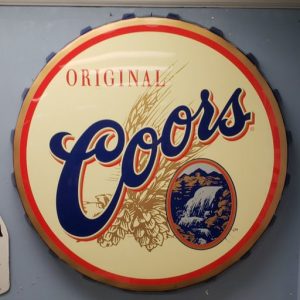
INTRODUCTION:
Coors Banquet beer is an American lager beer that was established on the base of the beautiful rocky mountains of Golden, Colorado, in the United States in 1873, by German immigrants Adolph Kohrs (later changed his sir name to Coors) and Jacob Schueler from Prussia The business partners bought a pilsner recipe from a Czechoslovakian immigrant and invested their funds together to purchase the Golden Brewer, on the Clear Creek of Golden Colorado banks that still stands today and boasts as the world’s largest single brewery facility. Coors Banquet is brewed with Moravian barley and Coors famously known for ingredient 100% pure Rocky Mountain water. A pale golden lager with the aromas and flavours of toasted grain, herbal hops, and pale malt delivers crisp carbonation of this full flavoured lager. Coors Banquet ingredients contain Rocky Mountain water, barley (Moravian and other varieties) malt, yeast, hops, grains, and corn which are standard and usual beer ingredients, but Coors goes the extra step through their dilution process to avoid the occurrence of gluten making this a gluten-free beer. Its alcohol by volume (ABV) is 5%, calories per 12 0Z serving are 149 cal with 11 carbs making this beverage a relative health choice.
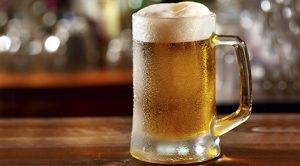
ORIGINS:
Adolph Coors and Jacob Schueler first established the Schueler and Coors Golden Brewery in 1873.
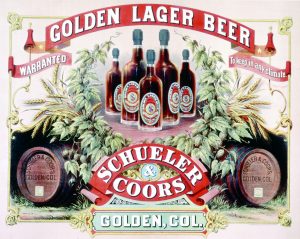
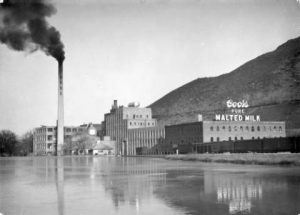
During this time there were 4, 131 breweries in the United States, today there are roughly 3, 464 breweries, making Coors a beer that is 147 years old, that has stood the test of time. In 1880 Adolph Coors bought out his partner Jacob Schueler’s interest and renamed the brewery Adolph Coors Golden Brewery. Coors made several enhancements to the brewery one of which included the rerouting of the Clear Creek so that the brewery could access the water from the creek more readily.
.

Amongst the Clear Creek Canyon miners Coors was given the nickname of the “Banquet Beer” as the minors would consume large amounts of the beer in large banquet tents and banquet halls. The name Coors Banquet did not become official until 1937. Coors Golden Lager was in high demand by the miners and every mining camp that tasted it applauded it and soon word of its excellence rapidly spread from camp to camp.

MILESTONES:
IIn 1916 a law called Prohibition came into effect in Colorado and Adolph Coors found he was unable to sell his beer. It is said that he dumped his wares into the creek to avoid legal repercussions, shortly after in 1920 nationwide Prohibition came into effect. Adolph along with his three sons Adolph Jr, Grover, and Herman established the Adolph Coors Brewing and Manufacturing Company. They entered into many ventures one of which was Herold Porcelain, well known for their tea-cups and dish wares (most porcelain was imported from war-ravaged Germany). The other was adapting the brewery into a malted milk and near beer production factory who sold much of their malted milk product to the Mars Candy Company and Hersey’s Chocolate Company. Their near-beer production produced a product named Manna a non-alcoholic beer replacement that had less than one half of one percent of alcohol by volume, this amount was allowable by law. The Coors family depended greatly on the profits from the porcelain manufacturing, malted milk, Manna, cement business, and real estate ventures to survive the Prohibition era, which they did, barely. 1933, after the end of Prohibition, the Coors brewery was one of only a few breweries that had endured. Sadly, Adolph Coors did not live to see the end of prohibition as he died on June 5, 1929, by committing suicide at the Cavalier Hotel in Virginia Beach by jumping from the sixth floor.
BREWING SCIENCE AND INDUSTRIALIZATION
Throughout its history, Coors has used innovative technologies to improve the quality of its beers. Coors Banquet is committed to the craft of how they brew their beer born from the result of keeping with their brewing tradition that can be traced back for generations. While Coors admits there may be a simpler method to brewing, they stand by their techniques. As they believe there no sense is changing what works so well.
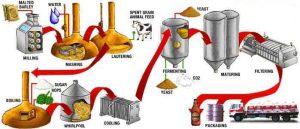
Coors believes malt can make or break the beer so they malt their own barley right at the brewery. Coors started a malting barley research station, which is now located in Burley, Idaho, where new and improved malting varieties are developed.
Coors Banquet is fermented using the classic technique of closed horizontal box fermentation, which is done at cold temperatures. The process lasts up to 30 days and plays a major role in giving Coors Banquet its distinctive banana characteristic.
Coors Banquet is filtered with Enzinger filters (which are a type of Pressure Filter for filtering beer which produces a longer shelf-life product for distribution.) In 1959; Coors moved away from pasteurization and implemented sterile filtration to stabilize their beer.
Coors Banquet is brewed in classic Huppmann kettles. ) You don’t see Huppmann kettles used too often anymore. As it’s a slow, traditional technique that requires patience and care.
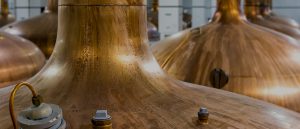
Coors is known as being aluminum innovators. Coors started its recycling program in the 1880s, offering 45 cents for a dozen returned quart bottles. In 1959 Bill Coors, the grandson of the company’s founder scrapped the traditional steel beer can in favor of the country’s first aluminum beverage can. The new material–along with Coors offering a penny for every can returned to the brewer– helped introduce the idea of recycling to the American public. Today Miller-Coors co-operates the nation’s largest aluminum can manufacturing plant in Golden. Coors and Ball Corporation joined forces in 2003 to create Rocky Mountain Metal Container; the nation’s largest aluminum can plant, located on a million square foot facility in Golden. The contract between Coors and Ball calls for the production of 4.5 billion cans per year to supply Coors breweries.
Coors is also an innovator in sustainability. Coors announced this year that all of its breweries are now “landfill-free.” Coors’ Golden, brewery was ahead of the curve, achieving landfill-free status in 2013. Coors now reuses or recycles close to 100 percent of all brewery waste, including everything from residual brewer’s grain and spent yeast, re-melted glass, aluminum, plastic, wood to other materials used in the beer-making process. Coors has also reduced energy use at its Golden facility by 50 percent since 2010. In 2016, the company stopped used coal at the Golden brewery and now uses only natural gas.
BEER STYLE
Coors Banquet is brewed with Moravian barley and Coors famously known for ingredient 100% pure Rocky Mountain water. A pale golden lager with the aromas and flavours of toasted grain, herbal hops, and pale malt delivers crisp carbonation of this full flavoured lager. Coors Banquet ingredients contain Rocky Mountain water, barley (Moravian and other varieties) malt, yeast, hops, grains, and corn which are standard and usual beer ingredients, but Coors goes the extra step through their dilution process to avoid the occurrence of gluten making this a gluten-free beer. Its alcohol by volume (ABV) is 5%; calories per 12 0Z serving are 149 cal with 11 carbs making this beverage a relative health choice.
Adolph Coors personal recipe for Coors Banquet beer included aromatic hops to bittering hops. Also using subtle blends of Chinook, Hallertau, Herkules, and Taurus hop is what is said to give Coors Banquet just the perfect hint of bitterness to offset the malty sweetness produced in each batch of brew. Adolph Coors received a gift in 1936 of Moravian Barley seeds that grow in what is now known as the Czech Republic. Those seeds were planted in an employee’s personal garden and used to brew the first batch of Coors Banquet beer. Even today, all of the barley used by Coors Banquet can still be linked to that original variety gifted to Adolph Coors 84 years ago.

The WI and WWII Era
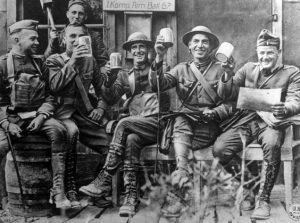
World War One posed a direct threat to the brewing industry as the government used war-time emergencies to impose grain rationing. This led to dropping the alcohol level of beer to 2.75 percent.
World War Two had a completely different effect on the industry: rather than output falling, beer production rose from 1941 to 1945.
During the war, the industry mirrored the nation at large by casting off its sluggish depression-era growth. As the war economy boomed, consumers, both troops and civilians, used some of their wages for beer, and per capita consumption grew by 50 percent between 1940 and 1945.
Another important change was how beer was sold. Preceding Prohibition, virtually all beer was sold on-tap in bars or saloons; and roughly 10-15 percent of the beer was bottled, as it was much more expensive than draught beer. In 1935, a few years after repeal, the American Can Company successfully canned beer for the first time. However, Coors started its recycling program in the 1880s, offering 45 cents for a dozen returned quart bottles, and then in 1959 introducing the country’s first aluminum beverage can. The new material along with Coors offering a penny for every can returned to the brewer helping to introduce the idea of recycling to the public. Today home refrigeration helped the consumer demand for canned and bottled beer, and from 1935 onwards, draught beer sales have fallen significantly.
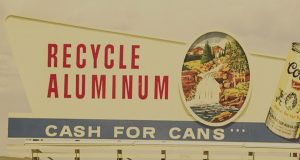
Consolidation and Globalization
- 1873 – Adolph Coors opens the Golden Brewery in Golden, Colorado.
- 1885 – Recyclable beer cans Coors launches its first recycling effort – 45 cents for dozen empty quart bottles.
- 1916 – 1933 – Prohibition hits Colorado in 1916 and then the nation in 1919. Miller and Coors survive by brewing soda, near-beer, and malt syrups until Prohibition is lifted in 1933.
- 1941 – Coors aids war effort by setting aside half of all beer brewed for the military.
- 1959 – Coors and Molson Canadian are introduced and established. Also, Coors introduces aluminum cans, cold filter brewing and launches an American recycling revolution by offering a penny for every can returned to the brewery.
- 1975 – Coors becomes a publicity traded company.
- 1978 – Coors Light is introduced and dubbed the “Silver Bullet.”
- 1989 – Coors/Molson merges with Carling O’Keffe, becoming Canada’s largest brewer and fifth-largest brewer on North America.
- 1995 – Coors launches Blue Moon and the Sandlot Brewery at Coors Field in Denver is the first brewery in a Major League Baseball Stadium.
- 2002 – Coors acquires the England and Wales-based business of Bass Brewers and creates Coors Brewers Ltd., the UK’s second-largest brewer.
- 2005 – Coors and Molson combine in a merger of equals. Later that year, the combined company acquires Creemore Springs Brewery in Ontario.
- 2008 – Coors Molson and SABMiller form a joint venture, Miller and Coors, which combines the U.S. and Puerto Rico business Miller/Coors logo.
- 2009 – Coors Molson purchases Granville Island Brewery in British Columbia.
- 2011 – Coors Molson creates a joint venture with Cobra Beer Company in India.
- 2012 – Coors Molson acquires Staropramen-maker, StarBev. Also, Coors Miller acquires Crispin Cider Company.
- 2013 – Coors Molson acquires Franciscan Well Brewery in Cork, Ireland.Franciscan Well brewery.
- 2015 – Coors Molson acquires Mt. Shivalik Brewery in India. Also, Coors Miller acquires Saint Archer Brewing in San Diego.
- 2017 – Coors Molson acquires Sharp’s Brewery of Rock, England.
- 2018 – Coors Molson acquires Clearly Kombucha of Fairfield, California.
- Coors Molson acquires Aspall Cyder of Suffolk, England.
- Coors Molson and HEXO Corp. form a Toronto-based joint venture called Truss to develop cannabis-infused beverages for the Canadian market.
- Coors Molson acquires Vukovarsko Pivo of Vukovar, Croatia.
- 2020 – Coors Molson changes corporate name to Molson Coors Beverage Company. Also, Molson Coors acquires Atwater Brewery of Detroit, Michigan.
Marketing and Branding
In the 1940s, the Coors Banquet beer sponsored radio’s “The Coors Show” which was a variety show featuring Duke Ellington and Mel Torme. In the ‘50s, Coors also sponsored one of the first TV series to air in Colorado, “I’m The Law”, which was a police drama starring gangster movie icon George Raft. In the 1960s, President Eisenhower and Gerald Ford insisted it be offered on Air Force One and further insisted it to be served at the White House mess every Thursday. The famous Dean Martin drank it in a western movie, and Keith Richards of the Rolling Stones kept it handy onstage. Let’s not leave out Paul Newman who told Roger Ebert (movie critic) that Coors Banquet is “The best domestic beer, bar none, is Coors.”
During Prohibition and through to 1976, Coors was available in only 11 states, as it is unpasteurized, contained no preservatives, and had to be kept cold, making long journeys just not an option to transport the beer. The first steps towards national distribution finally arrived in the 1950s when Coors helped develop the use of cold filtering, sterile filling, aluminum cans, and refrigerated trucks. This encouraged Coors Banquet beer to explode into American popular culture during the 1970s. What emerged encouraging a huge cult following for the beer. As Coors Banquet was not available east of Mississippi and was routinely smuggled back on long road trips, this fact was immortalized in the 1977 film “Smokey and the Bandit.

Coors Banquet was also the beer that inspired Clint Eastwood and Ray Charles to record a song called “Beers to You,” for Clint Eastwood’s movie” Every Which Way but Loose” in 1978 featuring Clyde a beer-drinking orangutan. For some reason, the film couldn’t get permission to use the Coors Banquets likeness which was rumored to be not only Clint’s favorite beer but Clyde the orangutans as well so they substituted Olympia beer cans with Coors Banquet inside for filming.

When I think of Coors Banquet the raspy voice of Sam Elliott comes to mind as he did advertising for the beer in 2007 and again in 2019.
https://youtu.be/VGOjlGUeaTE
But most significantly (and one of the reasons I chose this brand for my beer) Coors Banquet is the beer E.T. got drunk on in the 1982 movie “E.T. the Extra-Terrestrial” (produced and directed by Steven Spielberg.) I remember giggling with my siblings as we watched E.T. down one beer after another. This also allowed for another marketing trend as the greatest “drink responsibly” advisory ever having a series of print ads and commercials for Coors Banquet having E.T. encourage consumers that instead of driving, they should “phone home”.
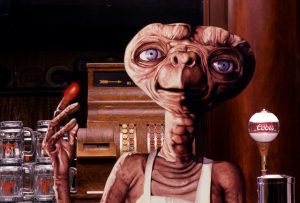
All of which has endorsed Coors Banquet to be one of the most recognized beers due to the iconic marketing and branding of this beer making it a household name for decades adding to its longevity and continued success.
Modern Era
A modern trend that is impacting Coors Banquet, is CoorsMolson and MillerCoors are under pressure to reduce a decline in sales of their top brands such as my beer Coors Banquet and attempt to revitalize brews that have been unsuccessful in keeping up with changing consumer tastes and trends. Such as the trend of consumers switching to low-calorie, low-alcohol or non-alcoholic brews as an approach to be part of the trend health and wellness movement being seen in the brewery industry. CoorsMolson and MillerCoors to meet this trend has stopped selling Coors Banquet in Canada as they feel this will result in reducing their carbon footprint with shorter transportation distances. They produced a new light beer called Two Hats in pineapple and lime flavors. Which they advertise as “Good, Cheap Beer” and a new ad campaign geared to appeal to millennial beer consumers who do not care about status and brand labels but are more focused on healthier alternatives that are budget friendly. Molson Coors, which owns MillerCoors, also has added craft players to its lineup and expanded its influence into other beverages after purchasing Aspall Cider, a nearly 300-year-old maker of premium ciders and specialty vinegars.
In 2019, Coors Banquet had its best year, and in fact it was one of the few brand-market beers to increase their sales and have continued to do so moving forward. Surprisingly what caused Coors Banquet’s sales rise, which is especially remarkable given the stronger market trends reducing large cooperate beer brands sales as more consumers turn to craft beer was their series of commercial advertisements that features the raspy voice of Sam Elliott as he did advertise for the beer in 2007 and again in 2019 which contributed to their soaring sales. The chairman of MillerCoors Pete Coors who also has appeared in several commercials said what he felt helped with the resurgence of Coors Banquet, was the brand’s success in consumers realizing that Coors Banquet simply tastes good. “It’s not a craft, it’s not retro, we’re just trying to help people understand that this is a really terrific beer that’s been around for a long time.” The craft movement appears to carry a lot of its focus on intense flavors and hops, which is likely why Coors Banquet became more appealing for consumers as it is not too hoppy or intense. Plus, the modern trend of retro products becoming more appealing a trend in itself only further benefited Coors Banquet sales as consumers jumped on the retro bandwagon trend. To further capitalize on these trends Coors Banquet introduced a throwback Coors Banquet bottle, that is a stubby bottle that resembles their first stubby beer bottle that they sold in the post-prohibition era in 1936.
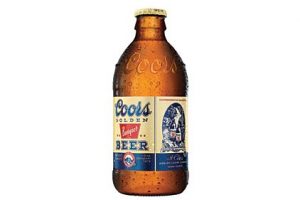
Coors Banquet also distributed four heritage cans focused on the brand’s history from the 1930’s, 1959, the 1980’s and 1998. They marketed on the fact that the production of this throwback bottle and the heritage cans not only met the need consumers wanted to connect with nostalgia but also met the need of sustainability. As the production of the bottles and cans saved on glass ( smaller bottle) and as aluminum cans are considered a “greener alternative” it allows for a smaller carbon footprint in regards to manufacturing, transporting, and as these products are more likely to be recycled which also appeals to the environmental friendly consumer. All this being said its shocking that Coors Banquet has yet to make it on to the top 20 bestselling beers list in North America. The beer sommeliers from the Beer Advocate collectively gave Coors Banquet a rating of 61 which put this beer into the category of poor as any beer with a rating score of under 60 is considered to be awful. However, Coors Banquet drinkers would certainly beg to differ as the brands has a loyal consumer base that continues to grow with new beer consumers increasing Coors Banquets popularity.
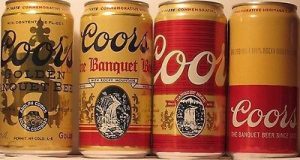
References
(Molson-Coors), C. (2020). Coors Banquet | Coors Brewing Company (Molson-Coors). Retrieved 16 April 2020, from https://www.beeradvocate.com/beer/profile/306/1276/
(2020). Retrieved 16 April 2020, from https://www.bevindustry.com/articles/86572-coors-banquet-pulls-designs-from-the-archives
Age Verification. (2020). Retrieved 16 April 2020, from https://www.coors.com/av?url=https://www.coors.com/heritage
COORS 2014 COMMORATIVE HERITAGE SET OF FOUR 12 FL. OZ. ALUMINUM CANS | #526987366. (2020). Retrieved 16 April 2020, from https://www.worthpoint.com/worthopedia/coors-2014-commorative-heritage-set-526987366
Coors Banquet 2015 – “Handshake”. (2020). Retrieved 16 April 2020, from https://youtu.be/9zCFR7u6qAY
New Coors Banquet bottle launches on June 1. (2020). Retrieved 16 April 2020, from https://beerpulse.com/2013/05/new-coors-banquet-bottle-launches-on-june-1st-390/
Top Rated Beers: United States. (2020). Retrieved 16 April 2020, from https://www.beeradvocate.com/beer/top-rated/us/
(2020). Retrieved 3 February 2020, from https://www.bizjournals.com/denver/news/2019/11/08/coors-brewing-colorado-timeline.html
Adolph Coors Facts. (2020). Retrieved 3 February 2020, from https://biography.yourdictionary.com/adolph-coors
Adolph Coors: Businessman. (2020). Retrieved 3 February 2020, from https://www.coloradovirtuallibrary.org/digital-colorado/colorado-histories/boom-years/adolph-coors-businessman/
AV | MillerCoors. (2020). Retrieved 3 February 2020, from https://www.millercoors.com/av?url=https://www.millercoors.com/breweries/coors-brewing-company/history
Blend, D. (2020). 15 things you didn’t know about Coors Banquet. Retrieved 3 February 2020, from https://www.thrillist.com/drink/nation/15-things-you-didnt-know-about-coors-banquet
Brewery. (2020). Retrieved 3 February 2020, from https://www.coors.com/brewery
How Coors made it through 17 years of Prohibition. (2020). Retrieved 3 February 2020, from https://www.thedenverchannel.com/news/local-news/malted-milk-and-tea-cups-how-coors-made-it-through-17-years-of-prohibition
Molson Coors Brewing. (2020). Retrieved 3 February 2020, from https://www.forbes.com/companies/molson-coors-brewing/
The story of Coors Brewing starts with a stowaway. (2020). Retrieved 3 February 2020, from https://youtu.be/ytWQfKByFDQ
Bell, E. (2020). The True Coors Bootlegging Story Behind Smokey And The Bandit. Retrieved 8 March 2020, from https://vinepair.com/wine-blog/smokey-and-the-bandit-and-coors/
Brewing process | Ielts, Process chart, Writing process chart. (2020). Retrieved 8 March 2020, from https://www.pinterest.ca/pin/82612974385651843/?nic_v1=1au3QGCtUwj1BrXa2KQ9kxd5UmG9hAoid0eCHgIX%2FeCtDFwt9LlcUgCfeomK1MB2jV
Coors Brewing Process | Coors Banquet Beer. (2020). Retrieved 8 March 2020, from https://www.coors.com/process
Don’t Let Your Hop Crop Flop! | Crop Insurance Solutions. (2020). Retrieved 8 March 2020, from http://cropinsurancesolutions.com/dont-let-hop-crop-flop/
E.T.: The Extra-Terrestrial (2/10) Movie CLIP – Getting Drunk (1982) HD. (2020). Retrieved 8 March 2020, from https://youtu.be/0xWMqsZOYWg
Every Which Way But Loose – Movie Forums. (2020). Retrieved 8 March 2020, from https://www.movieforums.com/reviews/1555142_every-which-way-but-loose.html
Heritage. (2020). Retrieved 8 March 2020, from https://www.coors.com/heritage
Rare Coors Beer Commercial with Sam Elliot (1996). (2020). Retrieved 8 March 2020, from https://youtu.be/VGOjlGUeaTE
WW1: US Army doughboys enjoy a drink of beer somewhere on the Western Front during a lull. The entry of the US in the war c… | World war, World war i, World war one. (2020). Retrieved 8 March 2020, from https://www.pinterest.ca/pin/297800594081198351/?nic_v1=1ahQWiotRUVsw864g3zg%2FKkzn2V%2BDy4n1Nq6Std97phc1sdJTJBaHIbLe4ye5JqSFC

